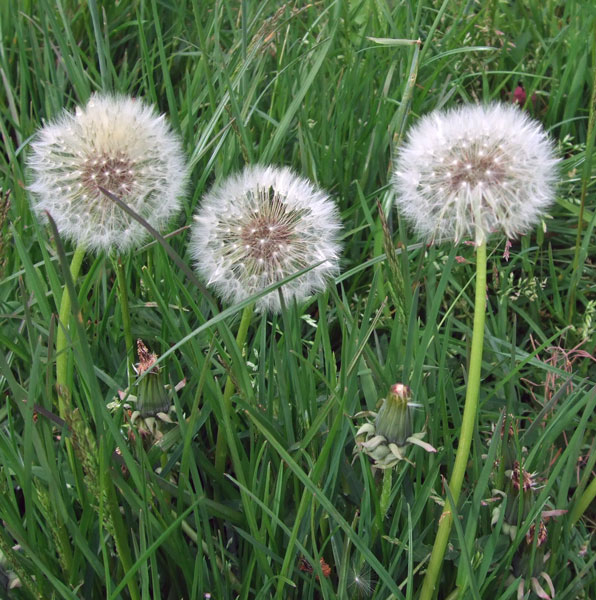 Botanical name: Taraxacum officianale
Botanical name: Taraxacum officianale
Family: Asteraceae
General information
The Dandelion is a common perennial weed, growing in a wide variety of conditions and sites, including fine turf, grassy pastures, roadside verges and areas of bare and waste ground.
This most recognise bale of weeds is initially seen during the early spring time with an abundance of yellow flowers.
Although it adds a splash of colour where ever it appears, it is the bane of gardeners and lawn care enthusiasts, as it simply spoils the appearance of well managed fine turf.
In the past dandelions have been used for medicinal purposes, however there is insufficient evidence as to their effectiveness. It has also been used as a food source as a salad green, herbal tea, wine and soups.
It forms as a basal rosette, quickly smothering and eventually killing the grass beneath it, if not removed or treated quickly. Dandelions anchor them selves into the root zone with a stout taproot, penetrating deep into the soil.
This causes problems with hand weeding difficult as the whole of the root has to be removed. If any part of the root remains in the soil, the dandelion will simply regenerate into another plant.
Dandelions can adapt to most mowing regimes. In fine turf lawns they will happily grow below the height of cut. On longer grass and waste areas where routine cutting is generally neglected they will grow somewhat taller.
Dandelion Identification
- Flowers: The dandelion has distinct yellow flowers that are borne on hollow fleshy stems (the stems ouse a white milky substance when broken). Each plant can produce several flowers at a time, measuring anywhere between 30mm – 60mm in diameter. As the flowers mature they produce a spherical seed head, with hundreds of air borne, parachute like seeds. These seed heads are often referred to as ‘clocks’ and are around the size of a golf ball.
- Leaves: Dandelion means ‘lions tooth’ which refers to the long narrow leaves, which have sharp toothed edges. The surface of the leaves are smooth. They are typically 5 – 25cm in length, but can grow longer. Like the flowers of dandelion, the leaves are similar other weeds in this family such as cats-ear, hawsbeard and hawkbit.
- Roots: This weed has a deep taproot (see image below).
Dandelion Images (click image to enlarge)
More images and free downloads
Prevention and control
Dandelion can be removed via hand weeding, however it will regenerate if any part of the root is not removed from the soil.
Hand weeding is best undertaken when the soil is moist. Using a small garden fork, gently lift the area around and including the weed, before gently teasing the weed from the turf, taking great care to remove the whole plant and the tep root.
As hand weeding dandelions can prove difficult at the best of times, a good alternative is to use a spot weeder and treat individual plants as they appear. Spot weeders can be purchased from most good garden centres and can prove a cost effective method of controlling weeds in turf.
Spot weeders come pre-mixed with a chemical solution and are ready for use straight from the bottle, simply spray the solution on to the weed using the trigger.
If the infestation is widespread then the only option left is to treat the infected area with a suitable selective herbicide. Dandelion is a relatively easy weed to control and is usually killed with a single application. However a second treatment is sometimes required for complete control. There are range of weed killers that should easily deal with this weed.
Recommended chemicals for the control of dandelions
2,4-D + mecoprop-p
2,4-D + dicamba
2,4-D + fluroxypyr
fluroxypyr + MCPA
fluroxypyr + mecoprop-p
Recommended products for dandelion control
Verdone extra (Clopyralid, Fluroxypyr, MCPA)
Resolva lawn weed killer (2,4-D, Mecoprop-p, MCPA, Dicamba)
Doff lawn spot weeder (2,4-D, Mecoprop-p, Dichlorprop-p)
Vitax Lawn Clear (2,4-D, Clopyralid, MCPA)
Vitax Green up weed & feed (Dicamba, MCPA)
Weedol lawn weed killer (Clopyralid, Fluroxypyr, MCPA)
Scotts lawn builder weed & feed (2,4-D, Dicamba)
Headland Relay Turf (Mecoprop-p, Dicamba, MCPA)
Headland Cabadex (Fluroxypyr, Flurosulam)
React Ultra (Mecoprop-p, Dicamba, MCPA)
Everris Praxys (Clopyralid, Fluroxypyr, Fluosulam)
Bayer Longbow (Mecoprop-p, Dicamba, MCPA)
Barclay Holster XL (2,4-D, Fluroxypyr, Dicamba)
Mascot Greenor (Clopyralid, Fluroxypyr, MCPA)
Mascot Junction (2,4-D, Flurosulam)
Mascot Crossbar (2,4-D, Flurosulam, Dicamba)
Vitax Esteem (2,4-D, Clopyralid, MCPA)




